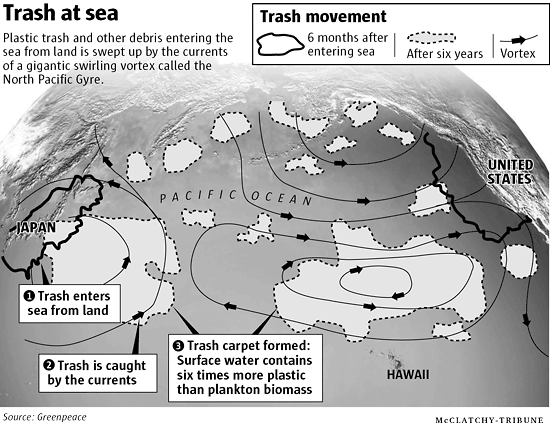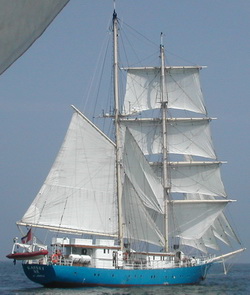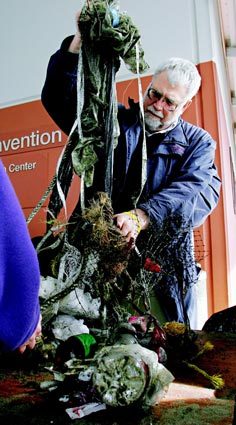|
Hoping to learn more about one of the most glaring examples of waste and environmental pollution on Earth, a group of scientists will set sail from San Francisco today to the "Great Pacific Garbage Patch," a massive vortex of floating plastic trash estimated by some researchers to be twice the size of Texas.
The bobbing debris field, where currents swirl everything from discarded fishing line to plastic bottles into one soupy mess, is about 1,000 miles west of California.
"This is a problem that is kind of out of sight, out of mind, but it is having devastating impacts on the ocean. I felt we needed to do something about it," said Mary Crowley, co-founder of Project Kaisei, a nonprofit expedition that is partnering on the voyage with the Scripps Institution of Oceanography in La Jolla, Calif.
Crowley, a Sausalito, Calif., resident who owns a yacht-chartering company, Ocean Voyages, has been sailing the Pacific Ocean for nearly 40 years. "More and more now, you see signs of marine debris and plastic everyplace. You can be at very remote beaches, and you'll see plastic bottles, barrels, toys, and a lot of plastic fishing nets," she said.
Not much is known about the Garbage Patch phenomenon, including when it began forming or even its exact boundaries. Scientists believe trash — most of it plastic that won't decompose — washes down storm drains and rivers from places like the Bay Area or Japan, eventually drifting into several large ocean vortices where currents swirl like water in a drain.
Crowley formed a nonprofit group, Ocean Voyages Institute, which has helped raise $500,000 to send two ships to the garbage patch. Today, one of those ships, the 151-foot Kaisei — which means "ocean planet" in Japanese — sets sail for a 30-day voyage from San Francisco.
|
The other ship, the 170-foot New Horizon, owned by the University of California-San Diego, left Southern California on Sunday. It has a crew of about 20 people, many of them graduate students in marine biology, funded by a $600,000 grant from the University of California.
Both ships will study the Garbage Patch's size, how the plastic affects wildlife, and whether it may be possible to clean some of it up.
"We are going to try to target the highest plastic areas we see to begin to understand the scope of the problem," said Miriam Goldstein, chief scientist of the Scripps expedition. "The team of graduate students will be studying everything from phytoplankton to zooplankton to small midwater fish."
The Kaisei also will take a documentary film crew and a group of international scientists. They will conduct similar research to the Scripps scientists, along with experiments on whether certain types of netting and other equipment can efficiently remove the trash, perhaps recycling it or converting it into fuel during future cleanup voyages.
But cleaning up the Pacific Garbage Patch may not be possible.
First, most of the plastic is broken into tiny fragments. Plastic becomes brittle from the sun's ultraviolet radiation and eventually breaks up into minuscule pieces like confetti. Billions float just below the surface in the garbage patch, which is located north of Hawaii but shifts in size and location depending on the season and the currents.
"The large pieces, it is possible to pull them out of the ocean," said Holly Bamford, director of marine-debris program for the National Oceanic and Atmospheric Administration (NOAA) in Silver Spring, Md.
|
"The small plastic bits, that's to be determined. Until we understand the extent, the size and exactly where they are, we won't be able to make a determination of how they can be removed or if they can be removed."
Bamford, who has a doctorate in atmospheric and oceanic chemistry, said the plastic harms wildlife. Not only have albatrosses and other sea birds died from ingesting plastic, which fills their stomachs without providing nutrition, plastic pieces also can absorb toxic chemicals, which then migrate up the food chain, even potentially contaminating fish that humans eat, she said.
Old plastic fishing lines, some from drift nets that weigh several tons, also entangle thousands of sea turtles, whales and marine mammals every year.
From 1996-2006, NOAA removed 1.1 million pounds of derelict fishing gear from the reefs and beaches of the Northwestern Hawaiian Islands, a chain of mostly uninhabited atolls and islands that stretch 1,500 miles from Kauai to Midway, near the Garbage Patch. The beaches on those islands, because of their proximity to the currents known as the North Pacific Gyre, often are littered with cigarette lighters, fishing line, floats, toothbrushes, bottle caps and other floating junk, some of which is decades old.
In the central Pacific, there are up to 6 pounds of marine litter to every pound of plankton, and roughly 46,000 pieces of plastic litter are floating on every square mile of the oceans, according to a 2006 report from the United Nations Environment Programme.
"This stuff is ubiquitous," Bamford said. "Plastics break into smaller and smaller pieces, but they don't decompose."
Seattle Times
For more information, visit:
Project Kaisei
Ocean Voyages Institute


